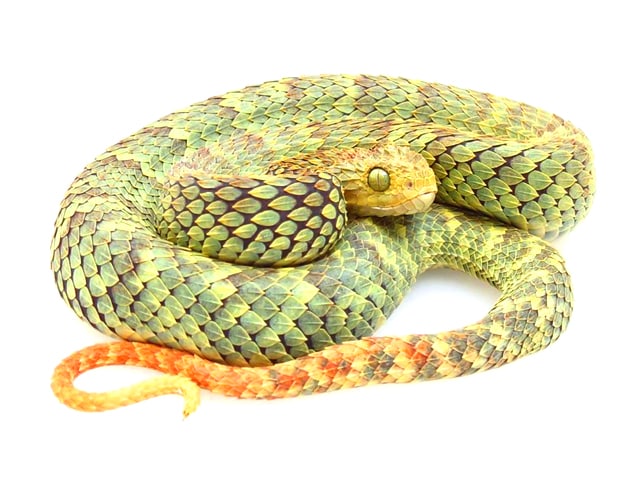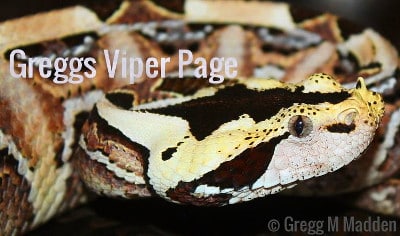Image Credit : Graeme Lotter
Atheris squamigera is an arboreal venomous snake. The head is broad and flat, distinct from the neck. The mouth has a very large gape. The head is thickly covered with keeled, imbricate scales. The body color is quite variable, ranging from uniform green to red, yellow, blue, black, orange or any combination of these colors.
Atheris squamigera may change coloration throughout life from birth to adulthood. The scales are heavily keeled, which leads to a somewhat hairy appearance. The tail is also prehensile and is used for grasping, and sometimes hanging from, branches to ambush unsuspecting prey.
- Scientific name : Atheris squamigera
- Distribution : West-Central Africa
- Average Size : 0.6 m (2 ft)
- Life Span : 10 years or more
- Difficulty : Advanced
Housing
As with any venomous animal, caging is a very important aspect of their husbandry both to create the proper environment for the snake and most importantly, SAFETY. Cages should be solid bodied with lockable sliding glass doors that open from the front. Minimal ventilation to keep heat and humidity in the cage. Screen lids are not recommended for reptiles that have medium to high humidity requirements and they are definitely not recommended for venomous reptiles as bites can happen through screen lids. For single animals or pairs, 0.6 meters (2 foot) cubes are acceptable. For larger groups, 0.9 x 0.9 x 0.6 meters (3 x 3 x 2 feet) is a good recommended start. Neonates can be kept in smaller cages or even secure rack draws suitable for housing small snakes and modified to safely house venomous snakes.
This species spends a lot of time perched up in branches and foliage. It is important that you offer lots of sturdy branches for climbing and perching. You should also add as much foliage as possible as this helps add to the snakes security. You can use live vines and plants if you like but it is much easier to find fake foliage and plants at craft stores. The more cover they have, the more secure and less stressed your Atheris will be. You will find this goes a long way when it comes to their overall health and success in captivity.
Hide box
Adding hide spots on the ground is also recommended, For an arboreal species, Atheris squamigera does spend quite a bit of time on the ground. Many will go to the ground while in shed and will not perch again until the shed cycle is complete. Gravid females will also tend to “ground” themselves for quite a bit of time. Ground hides like flat pieces of cork bark should be added. They will use these as cover when on the ground. If your substrate is set up properly, these ground hides will make for perfect cool, humid spots where they can go to help retain their moisture, to shed, and to even give birth to their young.
Substrate
In my opinion, substrate is a very important aspect of proper husbandry. You can use commercially available substrates like cypress mulch, aspen bedding, or even plain old paper towels. However, it is a far better option to use a deep, natural substrate that can help create a humidity gradient. I use about 0.12-0.15 meters (0.4-0.5 feet) of coco fiber mixed with sand and topsoil. This mix can hold lots of humidity without being saturated with water. A layer of leaf litter is thrown on top. This helps the soil to retain moisture for long periods of time and is a very natural looking and functional addition.
It is even more beneficial to make your natural substrate bio-active. Bio-activity in your soil will pretty much eliminate having to clean your cage or change your substrate. This crates a much healthier environment for your snakes. The use of isopods, wood lice, and springtails will give your substrate its bio-activity. They will keep the substrate and cage décor free of any fecal matter and fungal growth. Isopods, wood lice, and springtails will eat all decaying organic material and will also feast on fruit fly eggs and mite eggs. They will help to interrupt the life cycles of other parasites. You can not go wrong with a bio-active substrate. After a while, you will even have good bacteria cultured and it will help to eliminated harmful bacteria. Most of my bio-active cages have not been touched in years. The cages always have a fresh natural smell like walking through the woods.
Lighting – Heating
I offer my squamigera low levels of UVB during the day for 6 hours and heat lights for 12 hours. At night, all lighting is shut off. They are primarily nocturnal so they become very active during the night. A simple 12 hours on, 12 hours off will be sufficient for this species.
Contrary to popular belief, Atheris squamigera do very well with a wide gradient of temperatures. They will utilize hot basking spots. Offering a couple of basking spot that go above 32 °C (90 °F) will NOT cook your squam no matter how many people believe this silly myth. The ambient temperatures in their natural range go above 32 °C (90 °F) for days and even weeks on end. You can offer hot basking spots as long as they have a place to escape the heat when they need to. If you offer a hot basking spot around 32 °C (90 °F) with cooler ambient temperatures around 25-27 °C (78-80 °F), you will notice that A. squamigera will actively thermoregulate by moving from place to place during the day. Active snakes are healthy snakes.
Water
Large bowls of fresh clean water should be offered at all times. A. squamigera do venture to the ground. As they move around the bottom of their vivarium, they will find the water dish and drink from it if they need to.
Humidity
This is a very important part of husbandry for this species. They do very well when they have a good amount of humidity in the air. Spraying down the cage with water can help raise humidity in the air but deep natural substrates help to maintain a humidity gradient that will last a long time without being constantly sprayed down with water. An average between 70% and 80% is ideal in my experience keeping this species. Humidity levels may also trigger breeding behavior in this species.
Feeding
A. squamigeras natural diet consists of a range prey from frogs and small lizards to birds and small mammals. They adapt very well to an all rodent diet but it is a good thing if you want to vary their diet.
Neonates can be a bit of a challenge to feed if you are not used to feeding very small newborn snakes. Feeding neonate squams will involve cutting up pinky mice into small bits small enough for them to swallow. You may also need to tease feed them by tapping their tail tip with the food item in order to get them to strike. This may need to be repeated numerous times in order to get them to strike and actually hold on to the food item. After a few feedings, they usually take their prey item with very little to no coaxing at all.
Adults are usually never a problem to feed. Even fresh wild caught adults will take frozen thawed mice with gusto. Adults can be fed every 7 to 10 days. Gravid females should be fed more often because they will need the extra fats and nutrition for the developing embryos.
Feeding should be done with long tweezers or hemostats at the very least 3/4 the length of the snake.
Handling
Just like with any venomous snake, great caution should be taken when handling this species. Atheris squamigera is a highly toxic venomous snake that has caused a small number of reported human fatalities and a greater number of severe hematological complications in bite victims. There is also no antivenin for this species. This is not a species that should be taken lightly and it is definitely not a beginner species.
Handling should only be done with the use of hooks and other tools made specifically for the safe handling of venomous snakes. Free handling and tailing is not recommended and should never be an option.
Cleaning
When using bio-active substrates, cleaning and disinfecting is not needed.
If you are not using bio-active substrates, regular spot cleaning should be done whenever the cage is soiled. A full cage breakdown should be done once a month.
Shedding
Under the proper conditions, shedding for this species will go fine. They rarely ever have shedding issues.
Potential Health Problems
When husbandry is correct, Atheris squamigera is a very hardy species. Other than normal issues any species can have like mites, upper respiratory infections, and so on, wild caught specimens usually come in with large parasite loads. Mostly nematodes commonly referred to as worms. If your husbandry is on point and the animals stress levels are kept to a minimum, their immune systems will normally keep parasite loads in check. If you acquire an animal that does have worms and it is affecting the health of your snake, it is advised to see a vet and get the proper medications.
Bite Protocol
It’s highly recommended for every venomous species that you keep or interested to keep to have the bite protocol. Each species has a dedicated bite protocol that includes general information regarding the species, information about their venom and signs and symptoms of envenomation if bitten. It also includes a detailed information about first aid (what to do and what not to do), specific treatment recommendations for medical personnel to provide appropriate care including information about the antivenom or antivenoms required for treatment. Finally it includes a list of people who specialize in snakebites and their contact information so they can be consulted to assist with the care if needed and a list of all the references used for the create the protocol.
Source
The information contained in this care sheet reflect the opinions and methods of the mentioned breeder, based on their expertise and long-established experience.

